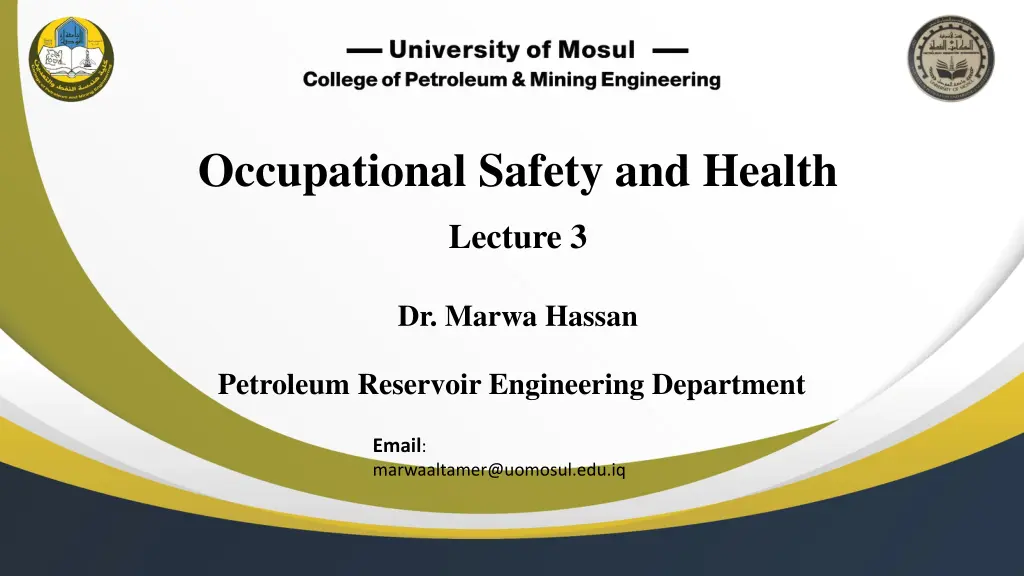
Hazardous Energy Control in the Workplace: Lockout/Tagout Systems Explained
Discover the importance of Lockout/Tagout Systems in preventing hazardous energy accidents in the workplace. Learn key terms, procedures, and safety measures to protect employees while servicing machines and equipment.
Download Presentation

Please find below an Image/Link to download the presentation.
The content on the website is provided AS IS for your information and personal use only. It may not be sold, licensed, or shared on other websites without obtaining consent from the author. If you encounter any issues during the download, it is possible that the publisher has removed the file from their server.
You are allowed to download the files provided on this website for personal or commercial use, subject to the condition that they are used lawfully. All files are the property of their respective owners.
The content on the website is provided AS IS for your information and personal use only. It may not be sold, licensed, or shared on other websites without obtaining consent from the author.
E N D
Presentation Transcript
Occupational Safety and Health Lecture 3 Dr. Marwa Hassan Petroleum Reservoir Engineering Department Email: marwaaltamer@uomosul.edu.iq
LECTURE CONTENTS Hazardous Waste Standard
Control of Hazardous Energy (Lockout/Tagout Systems) The purpose of this standard is to protect people in the workplace from hazardous energy while they are performing service or maintenance on machines, tools, and equipment. A key element of the standard is to prevent the accidental or inadvertent activation of a machine while it is being serviced or repaired. The lockout/tagout standard identifies the proper procedures for shutting down machines and equipment and locking or tagging it out so that accidental or inadvertent activation does not occur. The standard also calls for employee training and periodic inspections.
Lockout/Tagout Language The following terms and phrases are frequently used in the language of lockout/tagout. Safety and health professionals should be knowledgeable of these terms: Affected employee. Employees who perform their jobs in areas in which the procedure in question is implemented and in which service or maintenance operations are performed. Affected employees do not implement energy control procedures unless they are authorized. Authorized employee. Employees who perform service or maintenance on a machine and use lockout/tagout procedures for their own protection.
Energized. Machines, equipment, and tools are energized if they are connected to an energy source or when they still contain stored or residual energy even after being disconnected. Energy-isolating device. Any mechanical device that physically prevents the release or transmission of energy (for example, circuit breakers, disconnect switches, or blocks). Energy source. Any source of power that can activate a machine or piece of equipment (for example, electrical, mechanical, hydraulic, pneumatic, chemical, or thermal).
Energy control procedure. A written document containing all the information an authorized person needs to know in order to properly control hazardous energy when shutting down a machine or equipment for maintenance or service. Energy control program. A systematic program for preventing the accidental or inadvertent energizing of machines or equipment during maintenance or servicing. This is sometimes called the organization s lockout/tagout program. Lockout. Placing a lockout device such as a padlock on an energy-isolating device to prevent the accidental or inadvertent energizing of a machine during maintenance or servicing.
Lockout device. Any device that uses a positive means to keep an energy-isolation device in the safe position to prevent the accidental or inadvertent energizing of a machine or piece of equipment. Tagout. Placing a tag on an energy-isolation device to warn people so that they do not accidentally or inadvertently energize a machine or piece of equipment. Tagout device. Any prominent warning device such as a tag that can be affixed to an energy-isolation device to prevent the accidental or inadvertent energizing of a machine or piece of equipment.
Selected examples of problems and corresponding actions. Problem Action Machine is operating without the safety guard. Stop machine immediately and activate the safety guard. Maintenance worker is cleaning a machine that is operating. Stop machine immediately and lock or tag it out. Visitor to the shop is wearing a necktie as he observes a lathe in operation. Immediately pull the visitor back and have him remove the tie. An operator is observed disabling a guard. Stop the operator, secure the guard, and take disciplinary action. A robot is operating without a protective barrier. Stop the robot and erect a barrier immediately. A machine guard has a sharp, ragged edge. Stop the machine and eliminate the sharp edge and ragged burrs by rounding it off.







